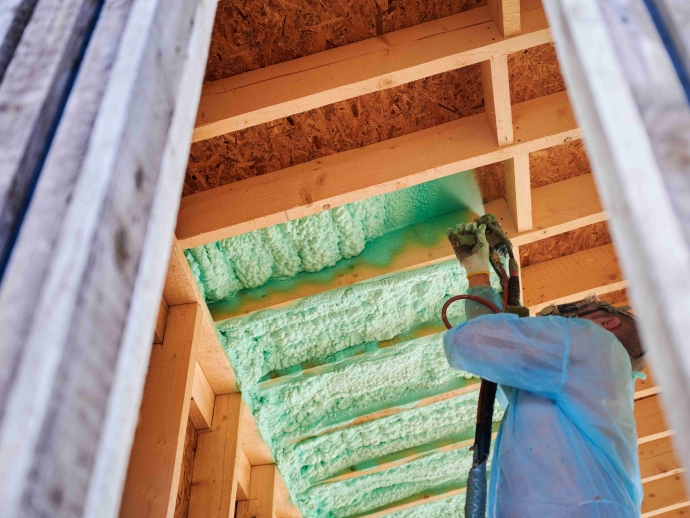The Complete Guide to Attic Insulation: R-Values, Materials, and Making Smart Choices in Texas

If you're like most Texas homeowners, you've probably winced at your summer energy bills. Here's a surprising fact: up to 40% of your home's heating and cooling energy could be escaping through a poorly insulated attic. Whether you're building a new home or looking to upgrade your existing one, understanding attic insulation is crucial for any Texas resident.
Understanding R-Values: Your First Line of Defense
Think of R-value as your attic's shield against Texas weather. But what exactly is it?
-
R-value measures insulation's ability to resist heat flow
-
The higher the R-value, the better the insulation performance
-
For Dallas-Fort Worth homes, the Department of Energy recommends R-values between R-30 and R-60
Pro Tip: Different areas of Texas have different optimal R-value recommendations based on climate zones. The DFW metroplex sits in Zone 3, requiring specific insulation levels for maximum efficiency.
Choosing Your Insulation Material
Let's break down the most common attic insulation materials:
Fiberglass Batts and Rolls The classic pink insulation you've probably seen in home improvement stores, fiberglass batts and rolls are one of the most traditional choices for attic insulation. These long blankets of spun fiberglass are designed to fit between standard wall studs and attic joists, making them a popular choice for both contractors and DIY enthusiasts.
-
Most widely recognized option
-
Easy to install in standard-sized spaces
-
Excellent for DIY projects in uncomplicated attics
-
Available with or without paper facing
Blown-in Fiberglass Similar to its batt counterpart but in a different form, blown-in fiberglass consists of small pieces of fiberglass that are mechanically blown into your attic space. This method has gained popularity due to its ability to fill every nook and cranny, creating a more complete thermal barrier in your attic.
-
Perfect for irregular spaces
-
Provides even coverage
-
Requires professional equipment
-
Excellent for topping up existing insulation
Cellulose Made primarily from recycled newspapers and treated with fire-retardant chemicals, cellulose has become an increasingly popular eco-friendly option. This material is particularly effective at filling small gaps and creating a dense insulation layer that helps prevent air movement.
-
Made from recycled paper products
-
Superior sound dampening
-
Fire-resistant treatment
-
Settles over time, requiring occasional top-ups
Spray Foam Perhaps the most technologically advanced option available, spray foam insulation starts as a liquid that expands into foam, filling every crack and crevice it encounters. This creates not only an insulation barrier but also an air seal, making it one of the most effective options available.
-
Highest R-value per inch
-
Creates an air seal along with insulation
-
Available in open and closed cell options
-
Professional installation required
Making Smart Investment Decisions
When considering attic insulation, several factors influence the overall investment:
Square Footage and Accessibility
-
Larger attics require more material
-
Difficult access points may increase labor costs
-
Existing obstacles like HVAC equipment affect installation
Current Insulation Condition
-
Removal of old insulation might be necessary
-
Moisture damage requires remediation
-
Air sealing needs should be addressed first
Key Questions for Your Contractor:
-
What R-value do you recommend for our specific situation?
-
How do you handle existing insulation?
-
What type of warranty do you offer?
-
Are you familiar with local building codes?
Installation Considerations: DIY or Pro?
While some homeowners might be tempted to tackle insulation as a DIY project, consider these points:
Professional Installation Benefits:
-
Proper evaluation of existing insulation
-
Expert handling of electrical and ventilation concerns
-
Access to professional-grade materials and equipment
-
Warranty protection
Common Installation Mistakes to Avoid:
-
Blocking attic vents
-
Improper vapor barrier installation
-
Missing air sealing steps
-
Uneven material distribution
Signs You Need New Insulation:
-
High energy bills
-
Uneven temperatures between rooms
-
Ice dams in winter
-
Visible wear or compression of existing insulation
Moving Forward: Next Steps
Ready to improve your attic insulation? Here's your action plan:
-
Schedule a professional energy audit
-
Get multiple quotes from certified contractors
-
Check for available local and federal incentives
-
Consider timing your installation during off-peak seasons
Remember, proper attic insulation is one of the most cost-effective ways to improve your home's energy efficiency. Through our directory, you can connect with qualified local contractors who can provide personalized recommendations for your specific situation.

